Communication Disorders Glossary with an emphasis on Children's Speech
- Details
- Created: Monday, 31 October 2011 14:31
- Updated on Saturday, 26 October 2019 12:04
This glossary relates to some of the aspects of speech-language pathology contained in this web site, and like the site in general it has an an emphasis on clinical phonology and children’s speech development and disorders.
Citing this Glossary
Cite glossary entries as:
Bowen, C. (2011). Communication disorders glossary. Retrieved from http://www.speech-language-therapy.com/index.php?option=com_content&view=article&id=14&Itemid=123 on [insert the date that you retrieved the file here].
ACE Awards
The Award for Continuing Education (ACE) is a formal recognition of professionals who have demonstrated their commitment to lifelong learning by earning 7.0 American Speech-Language Hearing Association (ASHA) CEUs (70 contact hours) within a 36-month period. The ACE is awarded only to those who earn ASHA CEUs through participating in the ASHA CE Registry. If an ASHA certified SLP does not have an ACE award, it does not mean that that person has not been earning CEUs. See also the Glossary entry for Certificate of Clinical Competency (CCC) below.
Affricate
Affricates - generally referred to as ‘the affricates’ - are individual consonants made with ‘affrication’. English has two affricates. The voiceless affricate is ‘ch’, heard twice in the word ‘church’, and the voiced affricate is the sound that is heard twice in the word ‘judge’.
The place-voice-manner (PVM) chart below shows the voiceless postalveolar affricate as in ‘etch’ and the voiced postalveolar affricate as in ‘edge’.
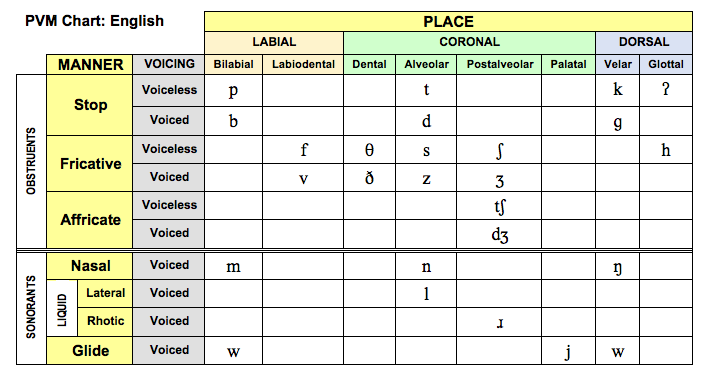
Age appropriate
See the Glossary entry for Within Normal Limits (WNL)
Air flow; Air stream
All speech sounds are produced by making air move in the vocal tract. This movement of air is referred to as the ‘air stream’ or ‘air flow’.
Alveolar
Alveolar consonants, or ‘the alveolars’, are made with the narrowest point of constriction of the air stream at the alveolar ridge. This point of constriction is called the place of articulation. The alveolars in English, as shown on either a Consonant Chart or a place-voice-manner chart are: /t/, /d/, /s/, /z/, /n/, and /l/.
The Place-Voice-Manner (PVM) chart below shows the voiceless and voiced alveolar stops /t/ and /d/, the voiceless and voiced alveolar fricatives /s/ and /z/, the voiced alveolar nasal /n/ and the voiced alveolar liquid /l/.

Alveolar ridge
The alveolar ridge is the hard, bony, bumpy ridge between the top of the upper teeth and the hard palate.
Approximant
An approximant is a consonant made with little obstruction to the air stream. The approximants in English are /l/ as in lay, /r/ as in ray, /w/ as in way and /j/ as in yay. In older terminology /w/ and /j/ were called semivowels. Note that the phonetic symbol for the first sound in the words ‘yay’ and ‘you’ is /j/.
Articulation
We can only produce, or articulate, the sounds of speech by moving body parts (by contracting and relaxing muscles), and by making air move. Most of the movements for speech take place in the mouth and throat, and the chest where breath is controlled. The mouth and throat parts are called ‘the articulators’.
The principal articulators are the tongue, lips, the lower jaw, the teeth, the soft palate (velum), the uvula and the larynx (voice box).
There are active articulators which can be moved into contact with other articulators (e.g., the tongue) and passive articulators which are ‘fixed’ (e.g., teeth, alveolar ridge, and hard palate).
Articulation Test
See the Glossary entry for Core Speech Assessment Battery
Associations
The Mutual Recognition of Professional Association Credentials (MRA) Signatories are ASHA, NZSTA, IASLT, RCSLT, SAC and SPA. Note that ASHA and SAC members may be speech-language pathologists and/or audiologists. NZSLT, IASLT, RCSLT and SPA membership does not include audiologists and audiologists in New Zealand, Ireland, the UK and Australia have separate professional associations. There is information about the MRA on the Speech Pathology Australia web site.
There is a full listing of MRA signatories and non-MRA signatories on the Speech-Language Pathology "START PAGE".
Audiogram
An audiogram is a graph of hearing thresholds measured in decibels hearing level (dB HL) as a function of speech frequency measured in Hertz (Hz). All children with hearing and/or speech and/or language issues require an audiogram.
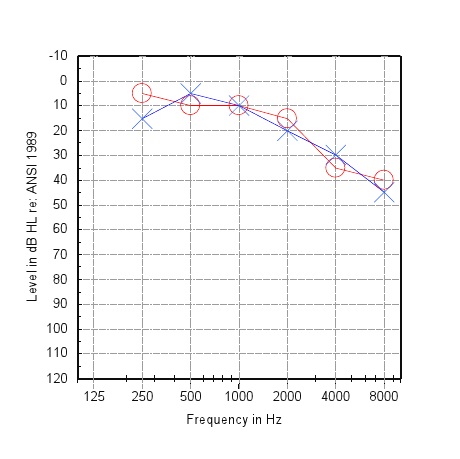
The one shown above (without the faces) and below (with faces) is a pure tone audiogram showing mild bilateral, high frequency hearing loss. Circles indicate right ear and crosses indicate left ear hearing thresholds. Hearing thresholds are considered normal if they are in the range -10 to +15 dB HL.
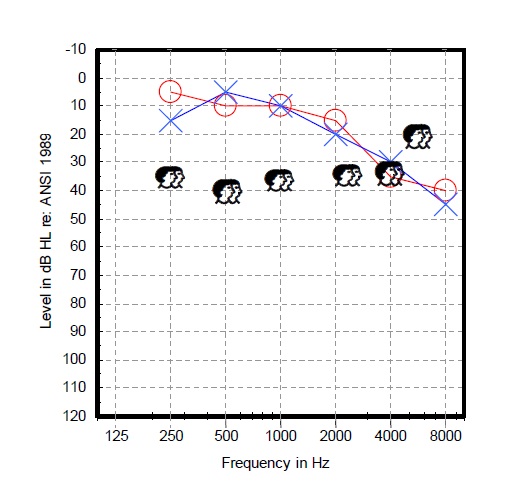
Hearing thresholds are considered normal if they are in the range -10 to +15 dB HL. The dB HL-scale represents hearing levels relative to the hearing of young ‘otologically normal’ 18-30 year olds. The face symbols on the graph represent the average speech level in each frequency region for conversational speech (59 dB SP at 1 m) spoken by an adult female. Even with this mild hearing loss, the highest frequency speech sounds (fricatives such as /s/) are close to the threshold of hearing, and speech energy above 4000 Hz is not audible. At greater distances more of the speech signal will be inaudible.
Hearing thresholds of 16-25 dB HL are classified a slight hearing loss, 26-40 dB as mild, 41-55 dB as moderate, 56-70 dB as moderate-severe, 71-90 dB as severe, and >90 dB as profound.
Babbling
In typically developing infants there is a gradual emergence of increasingly complex and speech-like utterances during the first two years of life. This period of non referential vocalisation is generally recognised as a foundation for meaningful speech and phonological development, and is called babbling.
Babbling proceeds in three stages: Precanonical, Basic Canonical Syllables, and Advanced Forms. Hear them at vocal development dot com
Backing
Backing occurs when /k/, /g/ and ‘ng’ replace /t/, /d/ and /n/ respectively. ‘Tell Teddy to shut Tim’s door’ sounds like ‘Kell Keggy koo shuck Kim’s gore’, and ‘Put the red pen in the bin’ sounds like ‘Pook the reg peng in the bing’. Backing can affect any of the obstruents shown on the place-voice-manner chart below (e.g., chew = coo or goo, ship = kip or gip). Backing is not seen in typical development in English, and is not a ‘natural’ or developmental process. Any child who is backing should be referred to a speech-language pathologist for assessment.
Blend
See the Glossary entry forConsonant Cluster
CCC
See the Glossary entry for Certificate of Clinical Competency (CCC) below
CEU
Continuing Education Unit
CPD
Continuing Professional Development
Certificate of Clinical Competency (CCC)
The initials CCC stand for Certificate of Clinical Competency. If a speech-language pathologist who is certified by the American Speech-Language Hearing Association (ASHA) has these initials after his or her name, they have (1) received a masters degree in Speech-Language Pathology (2) passed a national exam in speech/language pathology, (3) completed a 9 month clinical fellowship year (CFY) under a qualified supervisor.
In the United States quite a large proportion of school Speech Therapists do not have the CCC (or C's) - though most (more than 70%) do. Usually, the title ‘Speech Therapist’ in the US implies that the person is NOT a CCC-SLP. But you do need to check by asking the Speech Therapist what his or her qualifications are. Some SLPs actually call themselves ‘speech therapists’! Confusing, isn't it?
Once a person has received the C's, they have to pay an annual fee to renew. As well they are required by ASHA to attain 30 hours of continuing education units (CEUs) every 3 years in order to maintain CCC status. The practice of continuing education has long been recommended by ASHA, but not actually required, until January 2005.
The Award for Continuing Education (ACE) is a formal recognition of professionals who have demonstrated their commitment to lifelong learning by earning 7.0 American Speech-Language Hearing Association (ASHA) CEUs (70 contact hours) within a 36-month period. The ACE is awarded only to those who earn ASHA CEUs through participating in the ASHA CE Registry. If an ASHA certified SLP does not have an ACE award, it does not mean that that person has not been earning CEUs.
In some states of the USA, SLPs are also required to be licensed. For example in Pennsylvania SLPs who work in the public school system have to maintain state licensure and this requires 20 hours of continuing education every 2 years.
Childhood Apraxia of Speech (CAS)
Childhood Apraxia of Speech (CAS) is a relatively rare Speech Sound Disorder (SSD) in which a child has difficulty planning and sequencing the movements required for speech, and difficulty with prosody. Most children with CAS have language difficulties in addition to their SSD. Most have a receptive-expressive gap, understanding language much better than they can use it to express themselves. CAS is regarded as a severe SSD and its incidence is less than 1% of a typical speech pathology caseload. Despite the similar sounding name, CAS is a different disorder from Apraxia of Speech (AOS) in adults, with different characteristics.
In 2007 the American Speech-Language-Hearing Association (ASHA) published a Position Statement and Technical Report on this significant speech sound disorder.
Childhood Apraxia of Speech (CAS) or Developmental Verbal Dyspraxia (DVD)?
ASHA and CAS
AHSA's preferred term is CAS. The ASHA definition of CAS includes apraxia of speech in children irrespective of aetiology (that is, whether idiopathic or acquired).
RCSLT and DVD
The preferred term proposed by the Royal College of Speech and Language Therapists (RCSLT) in the United Kingdom is Developmental Verbal Dyspraxia (DVD), using the word ‘dyspraxia’. The RCSLT definition, in its 2011 Policy Statement on DVD includes apraxia of speech in children in its idiopathic presentation, excluding from the definition children with acquired apraxia of speech. See the Glossary entry for Developmental Verbal Dyspraxia (DVD) below.
Cleft; Cleft lip; Cleft lip and palate; Cleft palate
A cleft is a birth defect caused by failure of the mouth parts to fuse during early foetal development. Some babies are born with cleft lip only, and this may be unilateral (affecting one side of the lip) or bilateral (affecting both sides). Some children are born with unilateral or bilateral cleft palate. Some are born with any combination of cleft lip/palate types.
Cluster Reduction; Cluster Simplification
Cluster Reduction, sometimes called Cluster Simplification, is a phonological process (phonological pattern) in which a consonant cluster is omitted (e.g., ‘oo’ for ‘blue’), reduced (e.g., ‘boo’ for ‘blue’) or replaced with another sound (e.g., ‘woo’ for ‘blue’) or replaced with another cluster (e.g., ‘dwoo’ for ‘blue’).
Consonant
A consonant is a speech sound in which the airstream is obstructed (at the place of articulation).
Consonant chart
The most familiar consonant chart (or phonetic chart) is the one provided by the IPA. It is a grid with manner of articulation on the vertical axis and place of articulation on the horizontal axis. Each cell of the grid has one or two symbols. Where there are two symbols in a cell the one on the left is a voiceless consonant and the one on the right is a voiced consonant. A consonant chart is different from a Place-Voice-Manner Chart (PVM Chart).
Consonant Cluster
A consonant cluster, or ‘cluster’, is a sequence of two or more consonants. For example, /fl/ in ‘flower’ and /skw/ in ‘square’. Some speech pathologists call consonant clusters ‘blends’ which is a term more correctly applied to letter sequences in written language.
Consonant Harmony
Consonant Harmony is a phonological process (or phonological pattern) in which one sound influences the way another sound in a word is pronounced. For example if a child says ‘tittytat’ for ‘kittycat’ the /t/ in ‘kitty’ and /t/ in ‘cat’ had impacted the production of the two instances of /k/, so that all the voiceless stops in ‘kittycat’ (both k’s and both t’s) are produced as /t/.
Core Speech Assesment Battery
The core speech assessment battery starts with an audiogram administered by an audiologist, an oral musculature examination performed by the speech-language pathologist/speech and language therapist (SLP/SLT), and a detailed history taken by the SLP/SLT.
Then follow the independent and relational analyses, with the SLP/SLT exercising clinical judgement with regard to how detailed these need to be.
Independent Analysis (Inventories and Constraints)
This analysis provides a view of the child’s unique system without reference to the target (adult) phonology. It comprises the inventories of 'what's there' in the child's system, and a listing of the constraints, or what's missing from the child's system.
Relational Analysis (Percentages)
The relational analysis provides a normative comparison between the child's speech sound system and an idealised version of the target (adult) system. It comprises the Percentage of Consonants Correct (PCC) in single words and conversational speech (if possible), the Percentage of Vowels Correct (PVC) in single words and conversational speech (if possible), a phonological analysis, a phonotactic analysis, and a syllable stress pattern inventory.
Not all errors will necessarily be of one type
Some children experience more than one type of problem concurrently. In the same child, some errors may have: a phonetic basis; a phonological basis; a perceptual basis; an anatomic/structural basis; a motor planning basis; or, a motor execution basis.
Further Evaluation
The outcome of the Core Speech Assessment Battery may prompt more assessment to rule in/out, for example, perceptual difficulties, motor speech disorder (a dysarthria and /or CAS), or to take an in-depth exploration of the child's stimulability (see the Glossary entry for Stimulability below).
Dental
A dental consonant is one in which there is approximation or contact between the teeth and another articulator. The dental consonants in English may be labiodental like /f/ as in ‘phone’ and /v/ as in ‘veil’ with contact between the top teeth and lower lip, or interdental (often referred to as "dental") like the ‘th-sounds’, /θ/ as in ‘think’ and /ð/ as in ‘them’.
The place-voice-manner (PVM) chart below shows four dental consonants: the voiceless and voiced labiodental fricatives /f/ and /v/ and the voiceless and voiced interdental fricatives (the ‘th’ sounds).

Developmental Patterns / Developmental Processes
Developmental patterns or developmental processes are speech simplifications produced by children that are found in typical development. They include Final consonant deletion, Reduplication Weak syllable deletion, Cluster reduction, Context sensitive voicing, Depalatalization, Fronting (fricatives, velars), Alveolarization (stops. fricatives), Labialization (stops), Stopping (fricatives, affricates), Gliding (fricatives, liquids), Deaffrication, Epenthesis , Metathesis and Migration.
Developmental Verbal Dyspraxia (DVD)
In 2011 the Royal College of Speech and Language Therapists (RCSLT) in the UK officially adopted the term Developmental Verbal Dyspraxia (DVD) in preference to Childhood Apraxia of Speech (CAS) – the preferred term of the American Speech-Language Hearing Association (see the Glossary entry for Childhood Apraxia of Speech, above).
DVD refers to children whose motor speech disorder is ‘idiopathic’, having no known cause, and a distinction is made between these children and children who have apraxia of speech due to a ‘known’ (organic) cause. This is in contrast to the way the term CAS is used to refer to Apraxia of Speech in children in all its manifestations, irrespective of whether the cause is ‘known’ or ‘unknown’.
Diphthong
A diphthong is like a two-part vowel containing a glide from one vowel quality to another, as in ‘fear’ (‘fee-uh’) and ‘tour’ (‘too-uh’).
Dysfluency
See Glossary entry for Stuttering
EBP
Evidence Based Practice
E3BP
E3BP is “the conscientious, explicit, and judicious integration of
- best available external evidence from systematic research,
- best available evidence internal to clinical practice, and
- best available evidence concerning the preferences of a fully informed patient.” (Dollaghan, 2007, p. 2)
Early 8, Middle 8 and Late 8
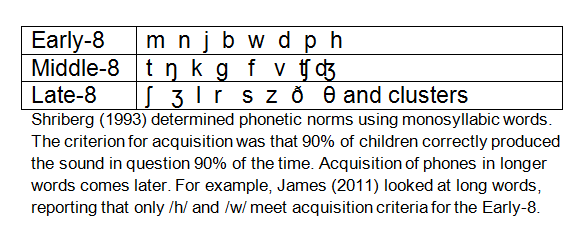
Final Consonant Deletion
Final Consonant Deletion is a phonological process (phonological pattern) in which children omit the final consonants of words; for example ‘time’ pronounced as ‘tie’ or ‘make’ pronounced as ‘may’.
Fluency disorder
See the Glossary entry for Stuttering
Functional
See the Glossary entry for Idiopathic
Fricative
A fricative is a consonant made by forcing air though a narrow gap, generating a voiced or voiceless hissing sound. The fricatives in English are found at the beginnings of the following words: ‘sue’, ‘zoo’, ‘shoe’, ‘fee’, ‘vee’, ‘thigh’, ‘thy’ and ‘high’, and as the second consonant ‘zh’ in the word ‘measure’.
The place-voice-manner (PVM) chart below shows the voiceless and voiced labiodental fricatives (/f/ and /v/), interdental fricatives (the ‘th’ sounds), alveolar fricatives ( /s/ and /z/) postalveolar fricatives ‘sh’, ‘zh’, ‘ch’ and dg’, and the voiceless glottal fricative (/h/).

Glide
‘Glide’ is a name sometimes used for an approximant articulation which resembles a vowel in quality. Glides are also sometimes called semivowels. The glides on the PVM Chart above are /w/ as in ‘woo’ and /j/ as in ‘you’.
Glue ear
See the Glossary entry for Otitis Media with Effusion (OME)
Homophony (homonymy)
Homophony is the term used to describe a child's production of different words the same way (e.g., 'coat', 'coach' and 'Coke' all pronounced as 'tote').
Hypernasal; Hypernasality
Hypernasal speech, or hypernasal resonance, sounds as though the speaker is ‘talking through his/her nose’. It is referred to as ‘hypernasality’.
Hyponasal; Hyponasality
Hyponasal speech, or hyponasal resonance, is characterised by a ‘blocked nose’ voice quality as though the speaker has a cold. ‘My mummy and Nanna made it for me’ sounds like ‘By bubby ad Dadda bade it for be’. It is referred to as ‘hyponasality’.
Identification
See the Glossary entry for Screening
Idiopathic
Idiopathic is an adjective used mainly in medicine meaning arising spontaneously or from an obscure or unknown cause. It is often used interchangeably with the term ‘functional’ which is sometimes used in medicine to describe symptoms that have no current visible organic basis.
Independent Analysis
See the Glossary entry for Core Speech Assessment Battery
Intelligibility
‘Intelligibility’ refers to the proportion of a speaker's output that a listener can readily understand. In typical speech development, children’s comprehensibility steadily increases. By their fourth birthday typically developing children are 100% intelligible to strangers.
Initial Consonant Deletion
Initial Consonant Deletion (ICD) is a phonological process (phonological pattern) that occurs when a child omits the first sound of many (but not necessarily all) words or syllables. For example, ‘Get me that nice orange Lego piece’ might sound like ‘Et me at ice or-ee eh-oh eese’. ICD is only found in typical development of Hebrew, Finnish and French. Any child learning English who deletes initial consonants should be referred to a SLP/SLT.
International Phonetic Alphabet
IPA Consonant Chart
The International Phonetic Alphabet is a system used to write down the sounds, syllables, intonation and separation of words in spoken language. It is based on the Latin alphabet with additional symbols. The (pulmonic) consonant chart is below, followed by the most recent version of the Full Chart (IPA, 2005).
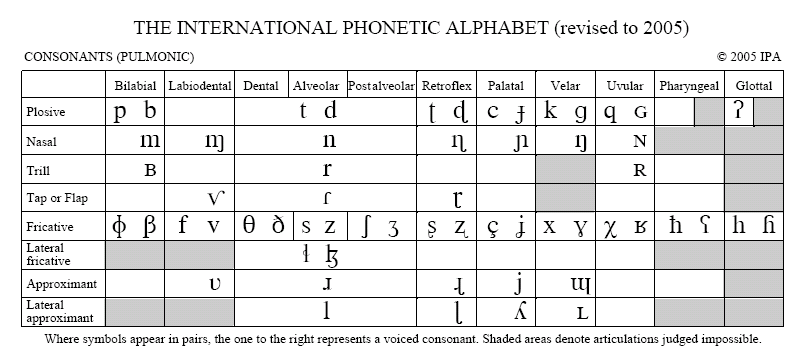
IPA Full Chart
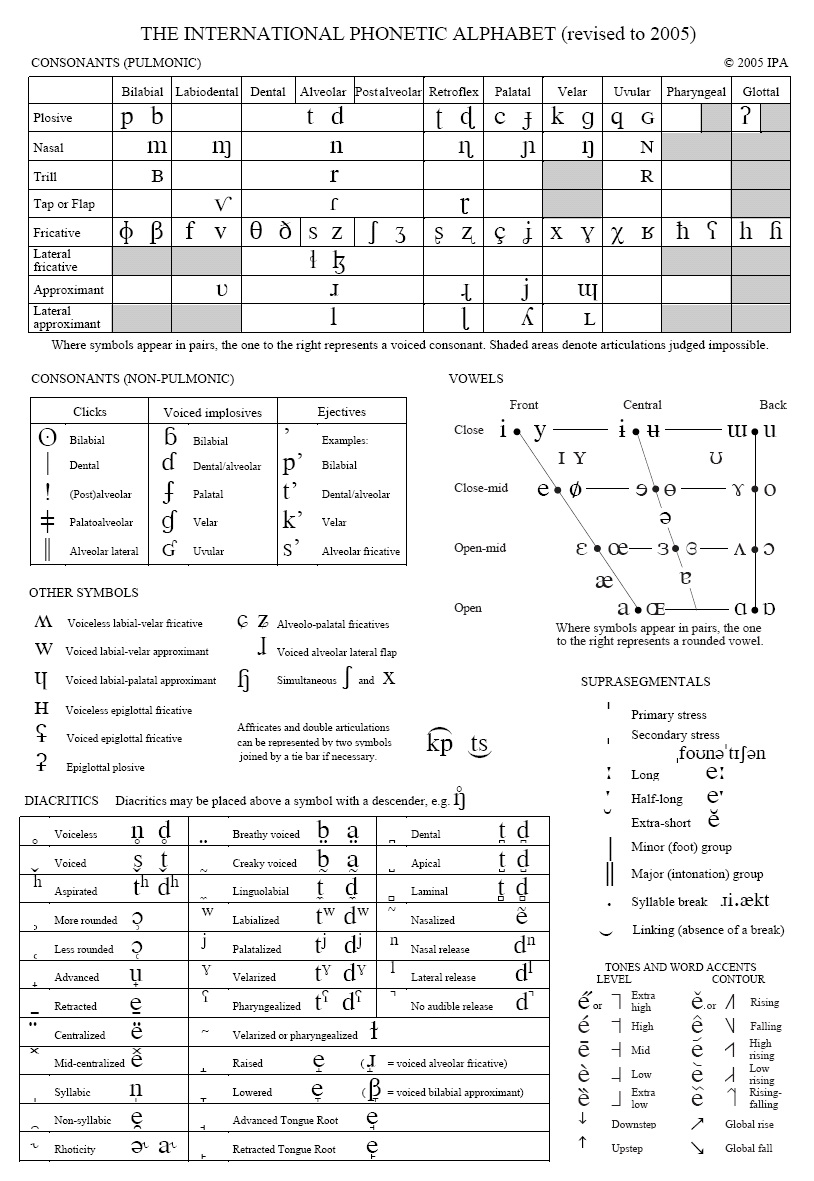
ICPLA Extensions to the IPA
When transcribing atypical speech (e.g., the speech of a person with a speech sound disorder related to cleft palate) symbols called the Extensions to the IPA (ICPLA, 2015), shown on the chart below, are used.
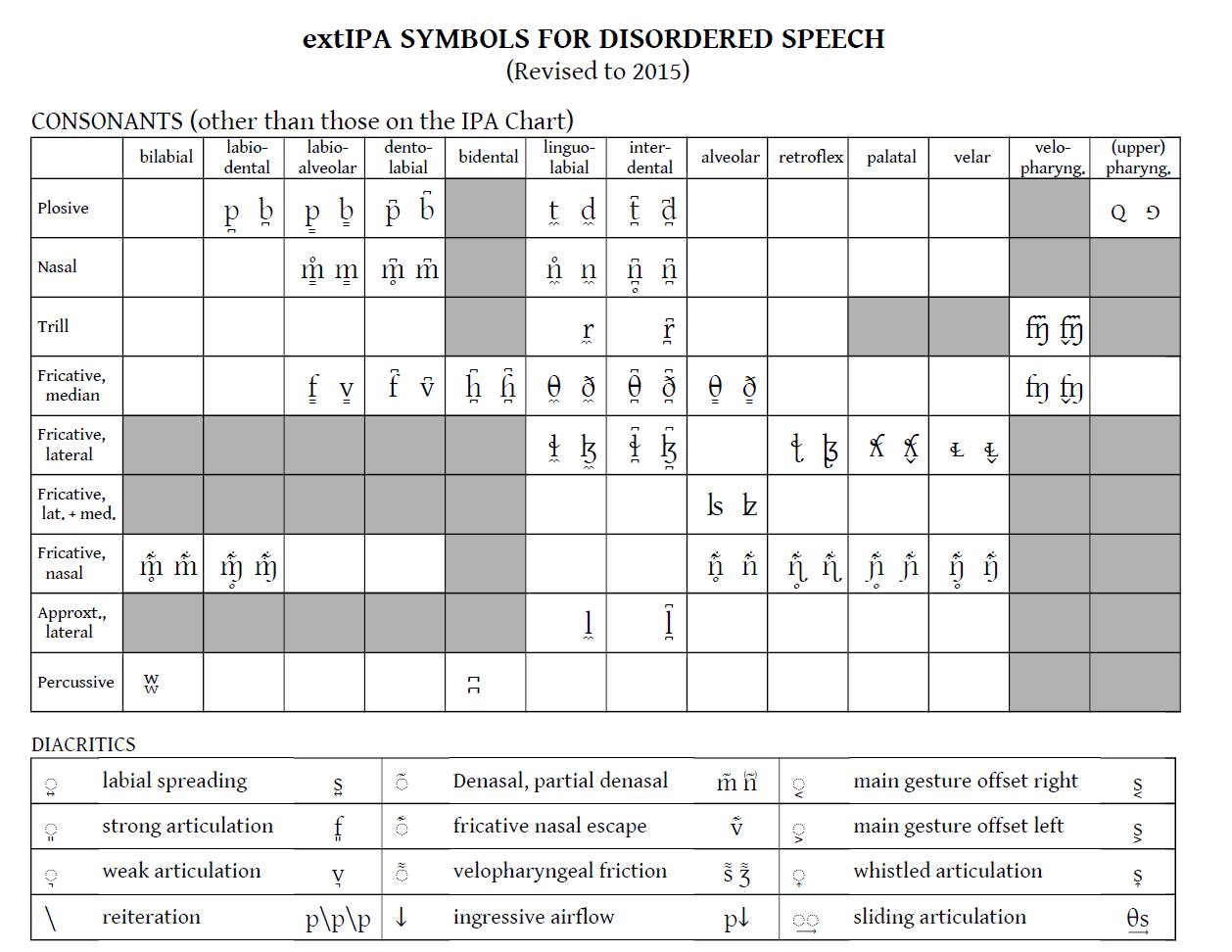
International Phonetic Association
The International Phonetic Association (IPA) is responsible for the development of the International Phonetic Alphabet (IPA).
Language
Language has been called the symbolisation of thought. It is a learned code, or rule system that enables us to communicate ideas and express wants and needs. Reading, writing, gesturing and speaking are all forms of language. Language falls into two main divisions: receptive language: understanding what is said, written or signed; and, expressive language: speaking (see 'Speech', below), writing or signing.
Language Assessment
A Language Assessment is a comprehensive evaluation performed by a speech-language pathologist / speech anf language therapist. It covers receptive language function (‘comprehension’), expressive language function (‘expression’) and the pragmatics of language use. It may involve standardised language tests such as the CELF or the CASL yielding Standard Scores and Percentile Ranks, and/or skilled informal and formal observations.
Language Disorder
A child with a Language Disorder (Language Impairment) exhibits receptive and/or expressive and/or pragmatic language abilities that are inappropriate (or not within normal limits) for their age, intelligence, etc.
Larynx
The larynx (‘voice box,’) is situated in the neck at the top of the trachea (‘wind pipe’). The larynx contains the vocal cords (vocal folds).
Liquid
Liquid is a term used to refer to /r/ and /l/. The lateral liquid is /l/ and the rhotic liquid is /r/, as shown on the PVM Chart below.

Lisp
‘Lisp’ is a widely used lay term for difficulties pronouncing certain sounds, particularly /s/ and /z/. Speech pathologists may use this term, but they are more likely to describe the nature of the error, for example ‘Interdental s’, ‘Lateral affricates’, etc.
Long word
A 'long word' has more than two syllables. Examples include: ambulance, hippopotamus, computer, spaghetti, vegetables, helicopter, animals, caravan, caterpillar, and butterfly. See the Glossary entry for Multisyllabic words.
Manner of Articulation
Consonants are classified in terms of their Place-Manner-Voice. The manner of articulation is the type of obstruction that occurs in the production of a particular consonant. The ‘manners’ of articulation are: Stop, Fricative, Affricate, Nasal, Liquid and Glide. The Stops, Fricatives and Affricates are termed obstruents, and the Nasals, Liquids, Glides, AND VOWELS are termed sonorants. The consonants /l/, /r/, /w/ and /j/ are also referred to as approximants.
Maximal Opposition
A maximal opposition cuts across many featural dimensions. For example the word pair bun-sun differs in place (labial is distinct from coronal), manner (stop is distinct from fricative) and voice (/b/ is voiced and /s/ is voiceless). The contrast fat-gnat is in place, manner, voice and major class (/f/ is an obstruent and /n/ is sonorant), and markedness (/f/ is marked, /n/ is not).
Minimal Opposition
A minimal contrast or minimal opposition is defined by one feature difference.
For example, sip-zip involves a minimal difference in voice; sip-ship involves a difference in place; and, sip-tip involves a difference in manner. A contrast like shape-jape is not quite ‘minimal’, differing in manner and voice. Test your knowledge.
Minimal Pair
A minimal pair comprises two semantically different words that also differ by one phoneme, e.g., me-knee, cry-try, bus-buzz, mat-mitt. See the Glossary entry for Near Minimal Pair below.
Modelling and recasting
Modelling and recasting are conversational techniques used by SLPs/SLTs, parents and teachers to help children’s speech and language development.
Multiple Opposition
Multiple oppositions are constructed when one sound is contrasted with many, as in ‘dip’ vs. ‘lip’, ‘ship’, ‘grip’ and ‘chip’ (dip-lip, dip-ship, dip-grip, dip-ship) in a treatment set in the variation of Minimal Pairs therapy called Multiple Oppositions Therapy (Multiple Oppositions Intervention).

MRA
See the Glossary entry for Associations
Multisyllabic words
Some experts define multisyllabic words as words of more than one syllable, and others define them as words of more than two syllables. There is a tendency among researchers nowadays to avoid the terms ‘multisyllabic words’ and ‘polysyllabic words’ and to use the terms ‘one syllable words’, ‘two syllable words’ and ‘long words’ instead. See the Glossary entry for Long words.
Mutual Recognition Agreement
See the Glossary entry for Associations
Nasal; ‘The Nasals’
‘Nasal’ means relating to the nose, e.g., ‘nasal consonant’, ‘nasal resonance’, ‘hypernasal’, ‘hyponasal’. Nasal consonants, commonly called ‘the nasals’, are made with air escaping only through the nose. To produce nasals the soft palate must be lowered to let air escape past it and down the nose. At the same time the soft palate must close off the opening to the oral cavity to prevent air from escaping through it. Children with cleft palate cannot do either, so their palates must be surgically repaired. There are three nasal consonants in English /m/ as in ‘rum’, /n/ as in ‘run’ and ‘ng’ as in ‘rung’.

The place-voice-manner (PVM) chart above shows the three nasals, all of which are voiced. The /m/ is bilabial, /n/ is alveolar, and ‘ng’ is velar.
Near Minimal Pair
Near minimal pairs occur in syllable structure contrasts, e.g., back-black, an-ant, up-cup, tinkle-twinkle, bee-bees, and relate to the inclusion or exclusion of a consonant. See the Glossary entry for Minimal Pair above
Non-developmental Patterns
Non-developmental patterns or non-developmental processes are speech simplifications produced by children that are not found in typical development. They include Initial consonant deletion (ICD is found in the typical development of Finnish, French and possibly Hebrew), Intrusive consonants, Backing (stops, fricatives, affricates), Denasalization, Devoicing of stops, Sound preference substitutions (Systematic sound preference), Deletion of unmarked cluster element, Glottal replacement and Final vowel addition. See the Glossary entry for Developmental Patterns above.
Obstruents
Obstruents, shown on the PVM Chart above, are consonants made by obstructing the airstream.
Otitis media with effusion (OME)
Otitis media with effusion (OME) is commonly called ‘otitis media’, ‘glue ear’, ‘middle ear disease’ or ‘middle ear infection’.
Palatal fronting
Palatal Fronting is a phonological process in which the palatal fricatives are produced as /s/ or /z/, so that ‘ship’ and ‘shine’ sound like ‘sip’ and ‘sine’ and ‘measure’ and ‘explosion’ sound like ‘mezza’ and ‘exploe-zun’.
Palate
The palate is the ‘roof of the mouth’. It comprises the hard palate which runs from the alveolar ridge at the front of the mouth to the beginning of the soft palate (velum) at the back; and the soft palate, which extends from the rear of the hard palate nearly to the back of the throat, terminating in the uvula.
Phoneme; Phonemic level
For many scholars the phoneme is the fundamental unit of phonology. Phonology, as an area of study, has shown that spoken language can be broken down into a string of sound units (phonemes), and that each language has a small, relatively fixed set of these phonemes. Most phonemes can be put into groups (stops, fricatives, etc.).
Phoneme Collapse
A phoneme collapse is a phonological rule. Phoneme collapses are seen as compensatory strategies that are organised according to aspects of adult system in terms of place and manner of articulation and voicing. Analysis in terms of phoneme collapses provides a holistic assessment of child’s speech that is child-based rather than adult-based (Williams, 2000a). The following example is of a phoneme collaps of one sound to many occasioning extensive homophony (different words pronounced the same way).

Phonetic development; Articulation development
Phonetic development is the development of the ability to articulate individual speech sounds or ‘phones’. The phonetic level takes care of the motor (articulatory) act of producing the vowels and consonants so that we have a repertoire all the sounds we need in order to speak our language(s).
Phonetic transcription
Phonetic transcription is the process of writing down a person’s speech using phonetic symbols. Speech-language pathologists in Australia and most of the world use the International Phonetic Alphabet (IPA) to do this. There are symbols for vowels, diphthongs, triphthongs, consonants, pauses and intonation to use in broad transcription, as well as numerous symbols called ‘diacritics’ to use in narrow (very detailed) transcription.
Phonetics
Phonetics, a branch of Linguistics, is the scientific study of speech. Sometimes a phonetic transcription is said to be written (or transcribed) ‘in phonetics'.
Phonemic development; Phonological development
Phonemic or phonological development is the gradual acquisition, by children, of an adult-like speech sound system. The phonological or phonemic level is in charge of the brainwork that goes into organising the speech sounds into patterns of sound contrasts so that we can make sense when we talk.
A five year old child with a phonemic (phonological) difficulty might find it impossible to make the sentences ‘He cut himself on the glass’ and ‘He cut himself on the grass’ sound different from each other (i.e., contrast with each other), perhaps pronouncing them both as, ‘He tut himseff on da bwaht’.
Phonological analysis
Phonological analysis is one component of Independent Analysis (see the Glossary entry for Core Speech Assessment Battery. In a basic phonological analysis the SLP/SLP phonetically transcribes single words and conversational speech and then evaluates what the child has in his or her phonological system, what is missing, and what intervention is needed.
In a detailed speech assessment for children with moderated through to severe SSD the SLP/SLT conducts both an Independent Analysis (looking at the child’s own system in detail) and a Relational Analysis (comparing it to the adult target system).
Phonological disorder
A phonological disorder is a speech sound disorder that affects the phonological (phonemic) level. The child has difficulty organising speech sounds into a system contrasts. These contrasts are called ‘phonemic contrasts’.
For a listener, the most obvious characteristics of phonological disorder are the child’s poor intelligibility, and the presence of homophony (homonymy).
Homophony is the term used to describe a child's production of different words the same way (e.g., 'coat', 'coach' and 'Coke' all pronounced as 'tote').
Phonological disorder is sometimes referred to as a Speech Sound Disorder that occurs at the linguistic, cognitive or language level.
Phonological processes; Phonological patterns
Phonological processes or phonological patterns are descriptions of the predictable, simplified productions (like ‘wabbit’ for rabbit, ‘boon’ for spoon, ‘lellow’ for yellow and ‘mato’ for tomato) typically found in young children’s speech when they are learning to talk.
The phonological processes include Final Consonant Deletion, Velar Fronting, Stopping, Gliding, Liquid Simplification, Cluster Reduction, Weak Syllable Deletion, etc. These perfectly normal phonological processes persist for longer in many children with Speech Sound Disorders, and of course this is not considered to be ‘normal’.
Phonology
Phonology is a branch of Linguistics and is the study of the speech sound system. Speech pathologists refer to ‘his phonology’ or ‘her phonology’ when talking about a child’s phonological system.
Place of Articulation
Consonants are made by obstructing or constricting airflow at some point in the vocal tract. The point of obstruction or constriction is called the place of articulation. The ‘places’ of articulation are Bilabial, Labiodental, Interdental, Alveolar, Palatal, Velar and Glottal. Note that there are other classification systems that differ slightly.
Place-Voice-Manner (PVM)
Consonants are classified in terms of their place of articulation, manner of articulation and voicing.
Place-Voice-Manner Chart; PVM Chart
The chart below is a PVM Chart showing the consonants of English. The voiced glide /w/ is included twice because it has two places of articulation, bilabial and velar. The glottal stop is also there because it occurs in some dialects (varieties) of English.

Plosive
See the Glossary entry for Stops
Polysyllabic words
Some experts define ‘polysyllabic words’ as words of more than one syllable, and others define them as words of more than two syllables. There is a tendency nowadays, however, to avoid the ambiguous terms ‘polysyllabic words’ and ‘multisyllabic words’, preferring ‘one syllable words’, ‘two syllable words’ and ‘long words’ instead. See the Glossary entries for Long words and Multisyllabic words.
Pragmatics
Pragmatics is the area of language function that embraces the use of language in social contexts: knowing what to say, how to say it, and when to say it - and how to ‘be’ with other people. Many children with pragmatic difficulties have unusual prosody and problems with knowing exactly how to modulate both voice and speech.
Prosody; Prosodic features
Prosody is an essential aspect of speech. Prosody or prosodic features are added to the sequences of speech sounds. These features include pitch, intonation (the rise and fall of the pitch of the voice), stress (emphasis), rhythm, voice quality, loudness and rate.
Refer; Referral; Referring
When a teacher or health professional identifies a student with a potential problem with communication, literacy or swallowing they refer the student for a Speech-Language Pathology Assessment / Speech and Language Therapy Assessment. They describe their concerns in simple language (usually in writing) and talk to the student’s parent/caregiver about the need for ‘referral for assessment’, helping them find an appropriate SLP/SLT.
The information and insights that teachers or health professionals provide to the SLP/SLT in the course of referral and also in ‘case discussion’ can be very helpful.
Relational Analysis
See the Glossary entry for Core Speech Assessment Battery
Screening
‘Screening’ (Roulstone, 2009) has at least three distinct meanings.
1. Early identification screening of at risk populations
This is a public health process in which children within a defined population (e.g., low birth weight infants; all pre-schoolers) are tested to identify those who are at risk of speech and language problems so they can be referred for further diagnostic testing. The aim of such screening is to provide early identification, so as to provide treatment at the earliest appropriate opportunity or as a preventative measure.
2. Informal Speech-Language Pathology / Speech and Language Therapy triage screening
This happens as part of the initial assessment process carried out by a speech-language pathologist. The experienced speech pathologist makes judgements about the priority status of each newly referred child in order to make best use of resources and monitor the urgency and needs of those being referred.
3. Formal screening assessment
Screening assessments are used to decide whether an aspect of speech and language requires further investigation. For example, the screening assessment of the DEAP allows the therapist to gain a quick overview of the child’s articulation and phonology in order to establish whether or not to carry out full diagnostic testing.
The first type of screening described above is a public health role, to be carried out by health and education professionals including preschool and school teachers.
Selectively mute children
Selectively mute children can speak but only do so with certain people or in certain places. For example, a child might speak at home to his/her parents but not to anyone at school (including his/her parents). A selectively mute child has an anxiety disorder and appropriate management is by a clinical psychologist or child psychiatrist. Many such children also have communication disorders, so a SLP/SLT may be involved, working collaboratively with the child, family and other professionals including teachers.
Semivowel
See the Glossary entry for Approximant
Soft palate; Velum
The soft palate (velum) extends from the rear of the hard palate nearly to the back of the throat, terminating in the uvula.
Sonorant
Sonorants are consonants or vowels produced without obstruction of the airstream (cf. Obstruent)
Speech
Speech is the audible expression of language, hence 'spoken language'. At a minimum, it involves the perception, articulation/motor production, and/or phonological representation of speech segments (consonants and vowels), phonotactics (syllable and word shapes) and prosody (lexical and grammatical tones, rhythm, stress and intonation).
Speech Banana
‘Speech banana’ is a term used to refer to the speech spectrum since speech is softest in both the very low and high frequencies and loudest at low-mid frequencies, producing a banana shape when plotted on the audiogram (see the Glossary entry for Audiogram above).
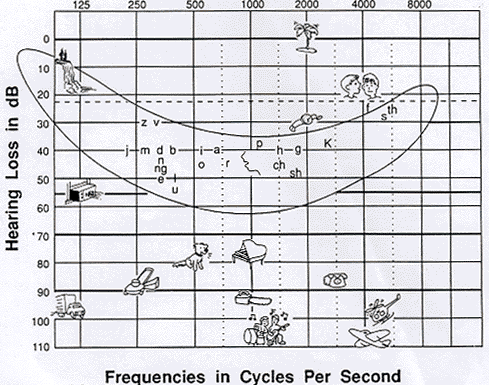
Speech Pathologist
In Australia speech-language professionals are called Speech Pathologists and their professional association is called the Speech Pathology Association of Australia, generally referred to as Speech Pathology Australia (SPA). The general public in Australia often call Speech Pathologists ‘Speech Therapists’ and the service they provide, ‘Speech Therapy’.
‘A speech pathologist has been trained to assess and treat people who have a communication disability. Speech pathologists complete a degree at university which encompasses all aspects of communication including speech, writing, reading, signs, symbols and gestures. Speech pathologists also work with people who have difficulties swallowing food and drink.’ Speech Pathology Australia
Speech-Language Pathologist
The professional associations in the US and Canada call their members Speech-Language Pathologists or Orthophonistes in French Canada. The general public may refer to them either as Speech Pathologists or Speech Therapists. For more information see the Glossary entry for Certificate of Clinical Competency (CCC) above.
Speech-Language Therapist; Speech and Language Therapist
The professional association in New Zealand calls its members Speech-Language Therapists, and the association in South Africa calls its members Speech Language Therapists.
Speech Sound Disorder; SSD
A Speech Sound Disorder (SSD) involves difficulty with and/or slowness in the development of a child’s speech. There are several classification systems associated with SSD.
SSD may be due to a genetically based linguistic processing deficit (60% of children with SSD); fluctuating conductive hearing loss/ ‘glue ear’ (30% of children with SSD); or a genetically transmitted deficit in speech motor control (10% of children with SSD). There is overlap between these areas (e.g., a child might have glue ear and a linguistic processing deficit).
Speech Sound
The speech sounds are vowels, diphthongs, triphthongs, and consonants.
Speech Sound System
Speech sound system is another name for the phonological system. It is a system of sound contrasts.
Stammering
Stammering is a synonym for Stuttering (see the Glossary entry for Stuttering below) and is the more commonly used term in the UK.
Stimulability
Traditionally, ‘stimulable’ has meant that a consonant or vowel can be produced in isolation by a child, in direct imitation of an auditory and visual model with or without instructions, cues, imagery, feedback and encouragement.
We know that if a child is not stimulable for a sound there is poor probability of short-term progress with that sound. That is, the sound is unlikely to ‘spontaneously correct’ or magically ‘become stimulable’. Since the late 1990s the child phonology literature has encouraged clinicians to target non-stimulable sounds, because if a non-stimulable sound is made stimulable to two syllable positions, using our unique clinical skills, it is likely to be added to the child’s inventory, even without direct treatment (Miccio, Elbert & Forrest, 1999).
The stimulability of a sound to two syllable positions is sometimes referred to as ‘true stimulability’.
Stops; Plosives
‘The stops’, are /p/, /b/, /t/, /d/, /k/ and /ɡ/. The glottal stop /Ɂ/ is also a stop. The terms ‘plosive’ or ‘plosive consonant’ are synonyms.
The place-voice-manner (PVM) chart above shows four voiceless stops (bilabial, alveolar, velar and glottal) and three voiced stops bilabial, alveolar and velar).
Stopping
Stopping is a phonological process (phonological pattern) in which a fricative is replaced by a stop (e.g., ‘sea’ pronounced as ‘tea’) or an affricate is replaced by a stop (e.g., ‘jig’ pronounced as ‘dig’).
Structural Processes
See the Glossary entry for Syllable Structure Process
Stuttering; Fluency disorder
Stuttering is a fluency disorder. Stuttering (called ‘stammering’ in the UK and parts of the US) disrupts the fluency of speech. Hence, ‘stutters’ are often referred to as ‘dysfluencies’ or ‘nonfluencies’. They may be in the form of prolongations, blocks or repetitions. One or any combination of these features may be present, consistently or variably. All children who stutter require assessment by a SLP/SLT.
Substitution Processes
See the Glossary entry for Systemic Process
Syllable Structure Process
Syllable Structure Processes (also called Structural Processes) are speech simplifications made by children in which the structure of a syllable or word changes.These phonological processes include the developmental processes of Reduplication, Final Consonant Deletion, Cluster Reduction and Weak Syllable Deletion, and the non-developmental patterns of Initial Consonant Deletion, Deletion of Unmarked Cluster Element, and Final Vowel Addition.
Syllable Trees
There are two ways of representing the contents of a syllable non-linearly:
-
Onset and rime (rhyme) syllable tree comprising
The onset: the initial consonant if any
The rime: the rest of the syllable
The Rime is further divided into
i. nucleus (the vowel or vowels
ii. coda (final consonant if any)
2. Mora syllable tree
The portion of the syllable that follows the onset consists of one or more moras.
Each mora is a unit of syllable time, or ‘weight’, and each one is a consonant (C) or a vowel (V). Typically the first mora of the syllable is a vowel. A diphthong is noted as two vowels (VV).
Onset and rime syllable tree

Mora Syllable Tree

Metrical Stress Syllable Tree
In a metrical stress syllable tree the word is broken up in to metrical feet with "S" indicating a strong syllable and "W" indicating a weak syllable.

Systemic Process
Systemic Processes (also called Substitution Processes) are speech simplifications made by children in which a consonant is replaced by a different (incorrect) consonant. Systemic processes include the developmental processes of Fronting (a front sound like /t/ replaces a back sound like /k/ so that ‘car’ is pronounced as ‘tar’), Stopping, Context Sensitive Voicing and Gliding, and the non-developmental processes of Backing, Denasalization, Devoicing of Stops, Systematic Sound Preference and Glottal Replacement where it is not dialectal.
Tongue
The most important articulator for speech production is undoubtedly the tongue. During speech, the amazing range of well-controlled movements the tongue can make includes tip-elevation, grooving, and protrusion. The tongue is almost entirely composed of muscle tissue. The parts of the tongue are the tip, front (the widest part), back (from the back teeth to the pharynx), and root (where it joins the lower jaw). It is anchored underneath by the lingual fraenulum.
Tongue-tie; Ankyloglossia
A tongue-tie (Ankyloglossia / Short fraenulum / Short fraenum) is a birth defect in which the lingual fraenulum, a band of tissue under the tongue, anchors the tongue too tightly from below so that the tongue has a ‘W’ appearance when the affected person tries to protrude it.
Tongue-tie may or may not affect speech, but all tongue ties should be checked by a SLP/SLT.
Triphthong
A triphthong is like a 3-part vowel containing a glide from one vowel quality to another, to another, as in the word ‘power’ (pow-oo-uh).
Tympanogram
Tympanography is used to monitor otitis media with effusion (‘glue ear’). It is a measure of energy transmission through the middle ear, and the results are represented as a tracing on a tympanogram.
Velar; 'The Velars'
Velar consonants, usually called ‘the velars’ are made at the velar place of articulation. There are three velars in English: /k/ as in ‘key’, /ɡ/ as in ‘go’ and /ŋ/ as in the final sound in ‘wing’.
Velum
See the Glossary entry for Soft Palate
Velar fronting
Velar fronting is a phonological process (phonological pattern) in which a velar consonant /k/, /ɡ/ or /ŋ/ is replaced by an alveolar consonant. So ‘colour’ sounds like ‘tulla’, ‘guy’ sounds like ‘dye’ and ‘wing’ sounds like ‘win’.
Vocal cords; Vocal folds
The vocal cords (or vocal folds) are composed of twin bands of mucous membrane stretched horizontally inside the larynx (voice box). They vibrate when we speak modulating the airflow from the lungs during phonation. Phonation refers to the production of sound by the cords. The sound itself is very quiet, but it is amplified by the resonators (cavities) it the head, neck and chest.
Vocal nodule; ‘Nodules’
A vocal cord nodule is a mass of benign tissue that grows on the vocal folds (vocal cords) affecting the sound of an affected person’s voice. ‘Nodules’ are common in young children and young adult females (particularly teachers).
Vocal tract
The vocal tract comprises the air passages from above the larynx to the lips and from above the larynx to the nostrils.
Voice
Voice is the sound produced by the vocal cords.
Voice disorder
Voice disorders are medical conditions affecting the production of the voice. Speech-language pathologists do not assess or treat people with voice disorders until the person’s larynx has been inspected by an Ear Nose and Throat (ENT) specialist.
Voiced consonants
A voiced consonant is made with vibration of the vocal cords. On a consonant chart (see below) they appear in the right hand position in a cell.
Voiceless consonants
A voiceless consonant is made without vibration of the vocal cords. On a consonant chart they appear in the left hand position in a cell.
Vowel
In speech, vowels are the class of sound which makes the least obstruction to the air stream. All vowels are voiced (made with vibration of the vocal cords) and all are sonorants.
Vowel chart; Vowel diagram
The most familiar vowel chart is the one provided by the IPA. The ‘front’, ‘central’ (or middle) and ‘back’ positions on the chart refer to the front, middle and back of the tongue.
Close, mid-close, open-mid and open refer to how high the tongue is elevated in the mouth for the production of a particular vowel. A ‘close’ or ‘high’ vowel sees the tongue high in the mouth and the jaw comparatively closed. An ‘open’ or ‘low’ vowel sees the tongue low in the mouth with the jaw comparatively open.
The chart does not show the three lip positions for vowel production, namely: rounded, neutral or spread.
Vowel Chart IPA 2005
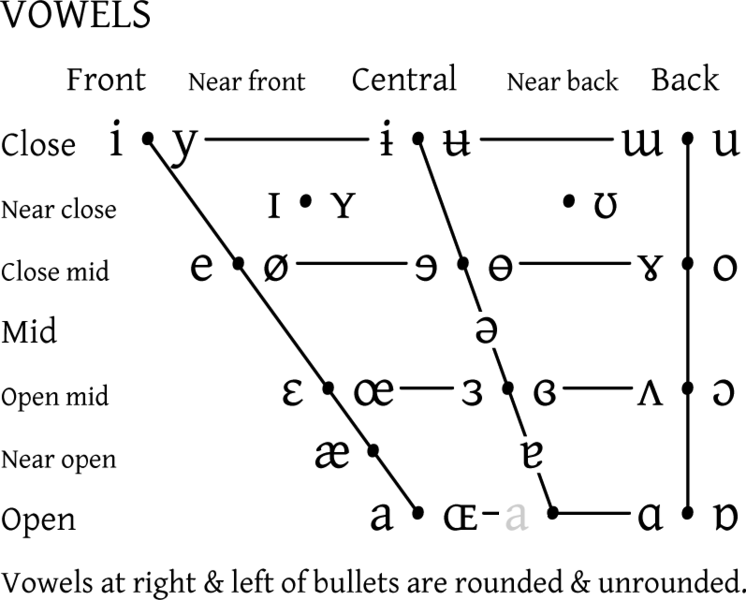
Vowel Chart SIL
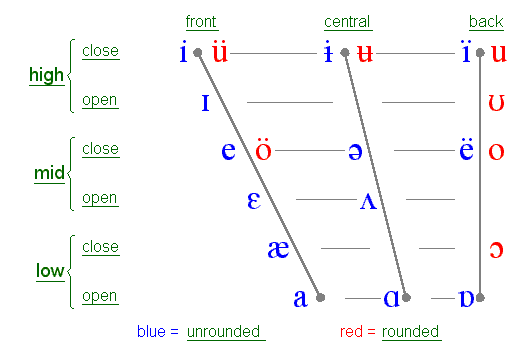
Weak Syllable Deletion
Weak Syllable Deletion is a phonological process (phonological pattern) in which the weakly stressed syllables in words are omitted; for example, ‘effant’ for ‘elephant’, ‘stake’ for ‘mistake’ and ‘member’ for ‘remember’.
Within Normal Limits; WNL
The term ‘within normal limits’, always abbreviated WNL, is used to indicate that no abnormal results were found during the testing of an individual child or adult. Another way of saying WNL in children is to report that a child’s performance when tested was ‘age appropriate’ or that the child’s results ‘fell within typical age expectations’.
